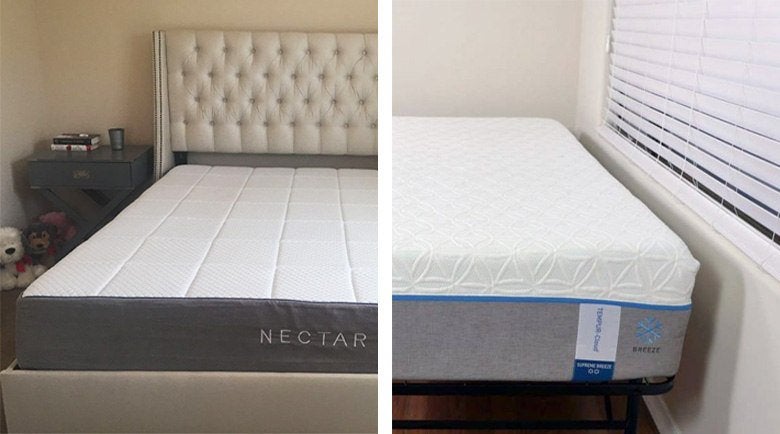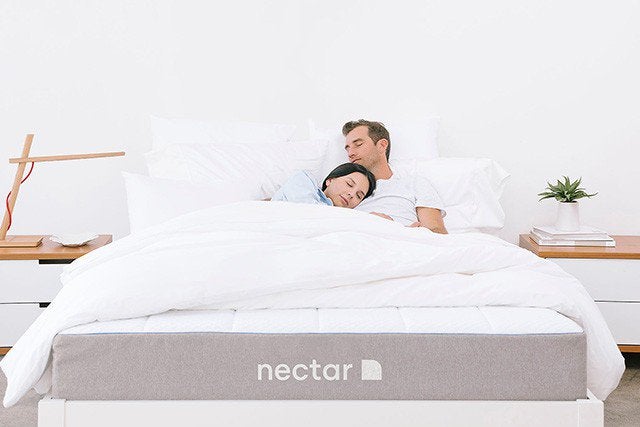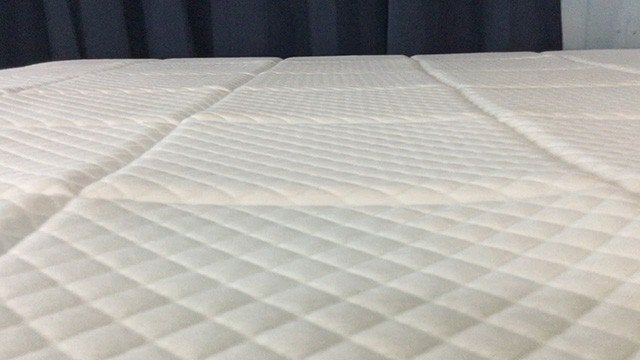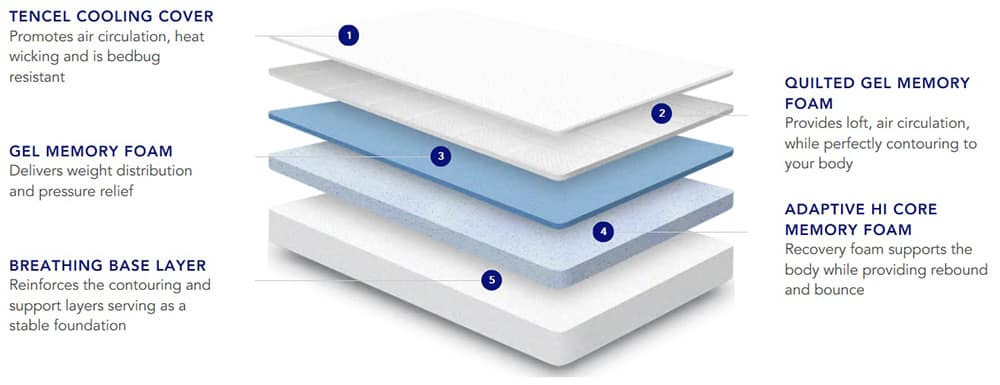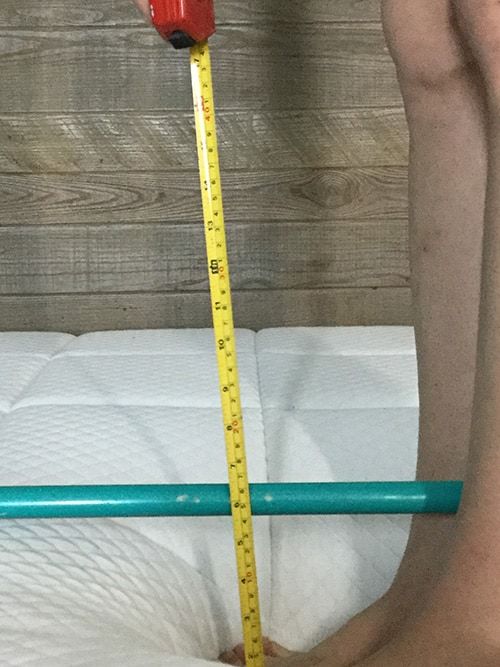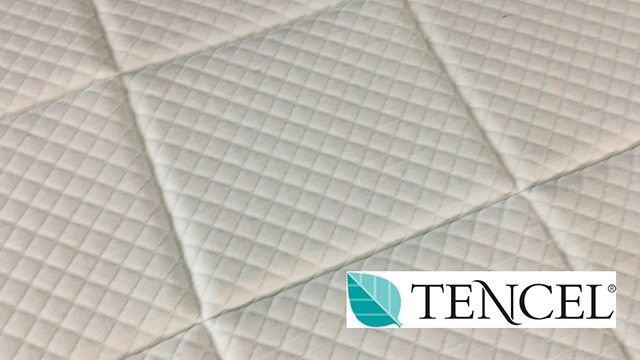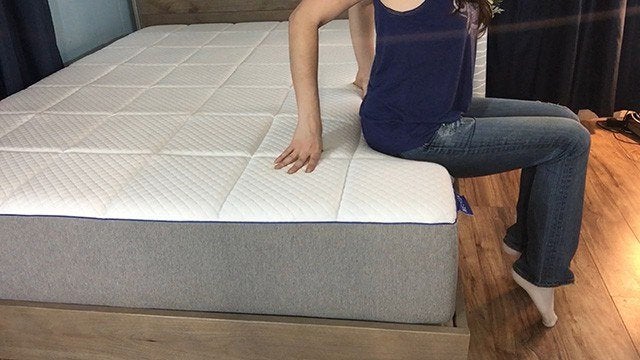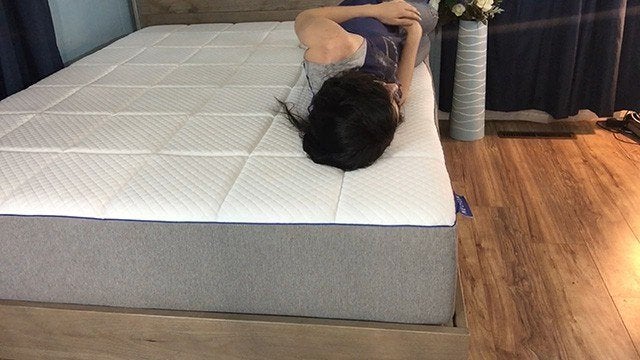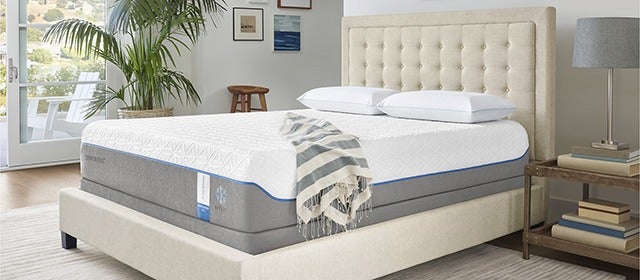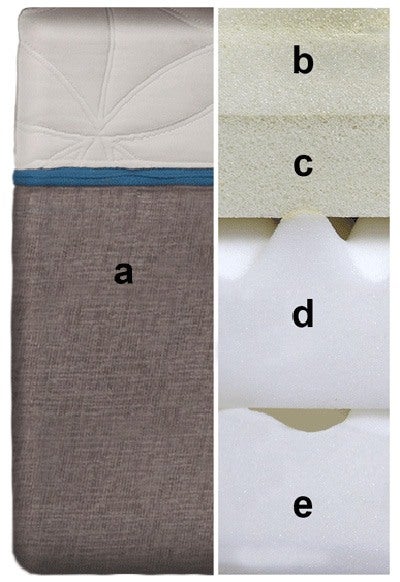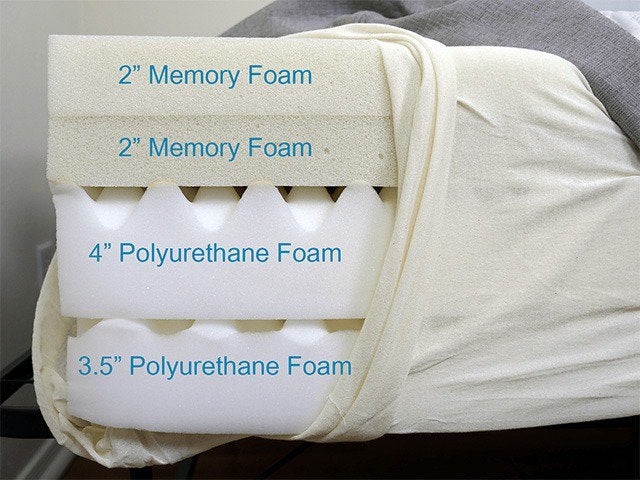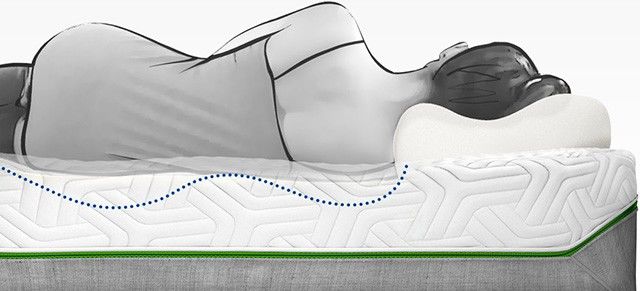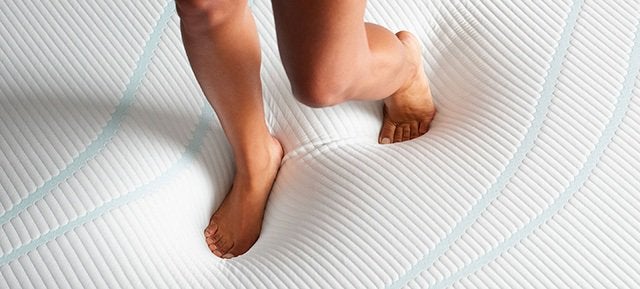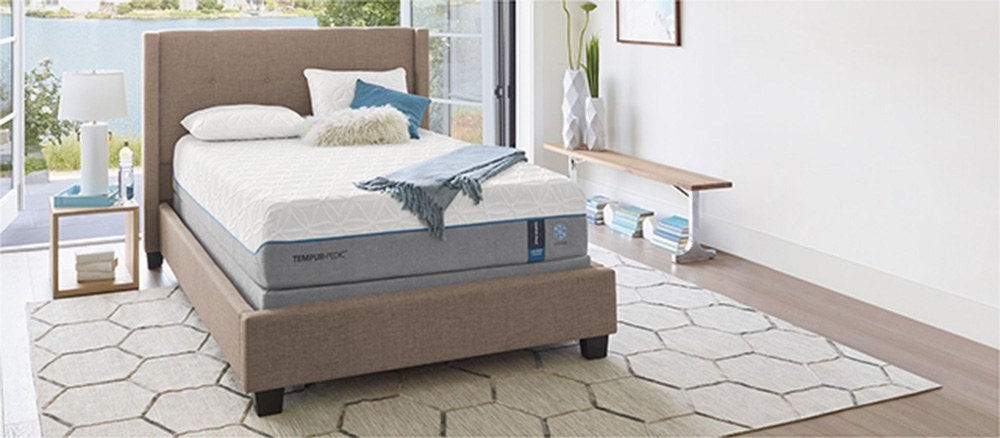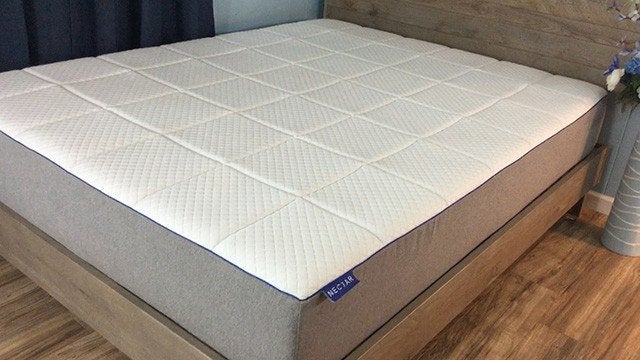With memory foam bedding having achieved an unprecedented level of popularity among sleepers over the past couple of decades, mattress makers have increasingly looked towards ways to counter the inherent heat retention problems associated with this material.
Nectar is one of the relatively new manufacturers in the mattress industry, owing its popularity to the rise of the online sales model, whose mattress (that shares the same name) tries several mechanisms to provide a viscoelastic experience that doesn’t succumb to heat up. Tempurpedic is a long established, formidable mattress maker that specializes in viscoelastic products, and their Cloud Supreme Breeze line of mattresses claims to be the culmination of their efforts to curb heat retention.
This Nectar vs Tempurpedic comparison will explore how these two fare against each other – hopefully, afterwards you’ll have a clearer idea of which one is going to give you a cooler sleep experience.
Nectar Breakdown
The Nectar mattress is viscoelastic foam / polyurethane foam hybrid that aims to offer a contouring yet adaptive sleeping solution for sleepers in a single, median firmness level and at a price that makes it accessible for everyone.
Construction
Cover
The cover of the Nectar is made from Tencel® fabric – this material is a derivative of eucalyptus pulp, and incorporates all its benefits: moisture absorption, breathability, and anti-microbial properties. It is also quite soft to the touch, so the end result is a highly comforting, cool, and safe surface for you to sleep on.
It is also worth noting that the manufacturer promises to replace your cover for free should your current one get damaged – an extremely generous move considering the already low price tag of the mattress.
First Layer
The Nectar’s uppermost layer is made from 1 inch of quilted gel memory foam at a plush ILD rating of 14. This makes it capable of absorbing the initial impact that your body makes with the bed, and also to adapt itself to your sleep posture. The quilting helps a bit in dispelling the ‘sinking’ feeling that regular memory foam exhibits, and the gel improves the heat dissipation properties of the mattress.
Second Layer
3 inches of somewhat stiffer 15 ILD gel viscoelastic foam make up the second layer – the slight increase in firmness slightly slows down the sinking behavior of the mattress, while also distributing your bodily pressure. This layer is responsible for the primary contouring capability of the mattress.
I should mention here that the Nectar mattress uses gel foam of the highest quality in this layer – ‘Lush Foam’. This foam is normally present in medical grade bedding.
Third Layer
A half inch of adaptive hi-core viscoelastic foam forms the transition layer of the mattress. This stiffer viscoelastic foam is designed to contour to your body, but also prevents the immediate impact from transferring further into the mattress, so that your body doesn’t sink all the way through. This layer is also sturdy enough to withstand distortion that would ordinarily be produced by the bodies of overweight sleepers.
Fourth Layer
This forms the core of the mattress – 5.5 inches of polyurethane foam. This layer is responsible for providing resistance against the deep pressure exerted by your body, ensuring that it is kept upright and in optimal spinal alignment throughout the night, so that you don’t suffer from a stiff neck / back / shoulders in the morning.
Air channels are incorporated in the polyurethane foam to enhance the passage of air and thus boost the heat dissipation of the mattress overall.
Firmness and Feel
The Nectar comes in just one level of firmness, which can be termed as medium-firm. Although it tips a little to the firm side, it is still clearly an attempt at a universal firmness level that accommodates a wide variety of sleep styles.
Comfort and Support
The Nectar’s two soft upper layers have all the trappings of a traditional viscoelastic bed – they adapt themselves to the contours of your body, so that you feel ‘hugged’ just as you would expect from memory foam. However, the next two layers get firm quite abruptly – going to 45 and 55 ILD values, in fact. This means that the upper layers aren’t able to completely engulf you inside them, and that the mattress does in fact have some resistance to your weight, which is atypical for many traditional memory foam products.
Motion Transfer
The upper viscoelastic layers of the Nectar are able to rapidly isolate motion to the point of impact thanks to their dull shock-absorbent nature. The surface thus remains undisturbed even if you’ve got a sleep partner who tends to move about quite a bit.
Cooling
Despite the breathability of the Tencel® fiber cover, the gel infusion in the memory foam layers, and the air channels created in the polyfoam base, the Nectar is unable to dissipate heat with total effectiveness. Of course, this is something to expect from any memory foam mattress, and indeed, it is much better than most of its peers in this regard.
Compared to the Tempur Cloud Supreme Breeze, there isn’t much of a difference in the heat dissipation performance – which is impressive considering that the former is a lot more expensive!
Edge support
Thanks to the exceptionally firm support and transition layers of this memory foam mattress, it is able to go against the norm and yield solid edge support. You’ll notice that sitting on the edges is quite easy – there is no noticeable slipping and sinking as is the norm for plush, yielding viscoelastic products (the Tempur Cloud Supreme Breeze included).
Unique Features
Seriously cheap price point
Price at just $799, the Nectar is one of the cheapest memory foam mattresses around that can be regarded as high-end. Aside from its (somewhat) questionable heat retention properties, it goes above and beyond in terms of adding value to your purchase – especially through its cover replacement policy, and it’s extremely generous return and warranty policies.
Contouring response with a degree of support
The Nectar’s plush upper layers are combined with an unusually (for a memory foam mattress) hard intermediate and comfort layer. This quirky approach lets the mattress yield the plush and adaptive initial response that memory foam is known for, without succumbing to the excessive sinkage problems that are common in the material.
In other words, the Nectar is able to work for heavier weight individuals better because it doesn’t yield all the way through under their weights. This added stiffness is also responsible, as mentioned above, for its markedly superior edge support.
Tencel® Cover
The Tencel® fabric cover of the Nectar enables the mattress to yield a comfortable and safe surface to sleep on, that has remarkable breathability, absorbency, and even packs anti-bacterial properties to boot. Even the Tempur’s high-end Breeze infused cover fabric cannot provide these capabilities, because it has artificial origins.
Extremely generous trial and warranty policy
The Nectar mattress shines when it comes to the length of the trial period and warranty that they offer. Their 365 day money back guarantee is better than anything that is offered in the industry at the moment, and can only indicate that manufacturer is certain that the mattress will be able to satisfy most customers in the long term.
This is further compounded by their lifetime warranty policy – which, again, is surprisingly generous for a mattress its price. Indeed, mattresses that are a lot more expensive than this hardly dare to venture past 15 years – even the vaunted Tempur series has a limited 10 year warranty!
Tempurpedic Breakdown
Tempurpedic’s Tempur Cloud mattresses embody the luxury and prestige that the brand is known for, and they incorporate the most notable innovations that the manufacturer has made with regards to memory foam. These mattresses are designed to be both completely conforming to your sleep style, and also quite resistant to the heat resistant issue that plagues ordinary memory foam products.
The reason why I’ve decided to cover the Tempur Cloud Supreme Breeze mattress in particular is that it has a Medium firmness level that is quite similar to the Relaxed-Firm firmness level of the Nectar. However, I should point out here that the Tempur Cloud series has a multitude of different mattress to choose from, all with different firmness levels, and you should feel free to explore those as well.
Construction
The Cloud Supreme Breeze’s core structure consists of four layers of foam that are wrapped up in a spandex/polyester cover.
Cover
The cover, as mentioned above, is built from polyester and spandex, but doesn’t look like a flimsy plastic wrapper in the least: it conveys a pretty high-end aesthetic. Moreover, it incorporates Tempurpedic’s signature ‘Breeze’ technology to enhance thermal dissipation by setting up a surface that transmits heat away from your body as soon as you lay down.
First Layer
The upper most layer is made from viscoelastic foam – 2 inches deep and 4.1 lbs./cu.ft. dense. This layer is responsible for yielding a highly cushioning and adaptive initial response that is the characteristic of all memory foam mattresses.
Second Layer
Next up is another 2” layer of viscoelastic foam that adds to the contouring response created by its preceding layer. It is, however, slightly less yielding in order to ensure optimum body weight distribution – so that you experience the ‘sleeping on a cloud’ feel that is cornerstone of the Cloud Supreme lineup.
Third Layer
The next layer is 4” of polyurethane foam with an egg-crate construction that lends it solid airflow capabilities. The purpose of this layer is to stop the weight of your body from pushing further inwards into the mattress after the two upper viscoelastic layers have molded to the applied pressure.
Fourth Layer
This 3.5” layer of polyurethane foam works in conjunction with the preceding layer to complete the support core of the mattress; together, these two layers keep your spine in proper alignment so that you don’t experience any muscle / joint stress in the morning. It too has an egg-crate construction, so it also contributes to the overall heat dissipation capability of the mattress.
Firmness and Feel
Comfort and Support
Memory foam is associated with slow-acting, contouring pressure relief that doesn’t bounce back rapidly against changes in pressure, and this is exactly the kind of response that you can expect to get from the Tempurpedic mattress, with its multiple layers of dense viscoelastic foam.
However, they are also a couple of layer of polyurethane foam in the support core, so you don’t have to worry about sinking all the way through, as these set up a decent amount of resistance to ensure that you are well supported throughout the night. This blend of viscoelastic contouring and light support is represented accurately by the ‘Medium’ firmness designation given to the Cloud Supreme Breeze mattress.
Naturally, as mentioned above, the comfort / support makeup will be different for other mattresses in the Tempur Cloud line.
Edge Support
The two top layers of the Cloud Supreme Breeze mattress are made from memory foam – so their response is pretty much expected to be pliable and contouring. This is reflected in the sub-par edge support of the mattress, which sinks as much as 3 inches when you sit on the sides (provided you’re normal weight!).
Also, I shall once again remind you that the edge support behavior will be different for other mattresses in the Tempur Cloud series. However, since they are all viscoelastic mattresses after all, you should still not expect as solid a response as a memory foam / innerspring hybrid can offer.
Cooling
This is one of the biggest advertising points of the ‘Breeze’ variants of the Cloud Supreme series, so I was particularly interested in investigating this. Firstly, the ‘Breeze material that has been incorporated into the cover of the mattress does indeed yield a cool-to-the-touch surface.
The previously described convoluted construction of the two polyurethane foam layers also allows for decent airflow, so the heat is removed from the upper memory foam layers before it starts to get unpleasantly hot. This appears to be true for the most part, but I would still advise temperature sensitive sleepers to be prepared for some heat retention – since this is an inherent limitation in memory foam because of the way it wraps around your body.
In any case, user complaints about heat retention in the Breeze models have been markedly less than those in the non-Breeze ones.
Motion Transfer
Viscoelastic foam is exceptional in its ability to absorb sudden impacts (it was designed as a seating material for NASA astronauts after all!), so it comes as no surprise that the Cloud Supreme Breeze, which uses it so extensively, is also superb in terms of isolating motion to the point of impact, so that sleeping with a restless partner does not translate into lost sleep for you.
Unique Features
Plenty of choices in terms of firmness levels
I’ve only covered one mattress from many that are available in the Tempur Cloud line. If you’re looking for a different firmness level than this one, chances are you will find it in the wide array of models that it contains. The same cannot be said for the Nectar, with its singular medium-firm level.
Cool-to-the-touch-surface
The ‘Breeze’ material that has integrated with the cover of the Cloud Supreme Breeze mattress removes heat from the surface as soon as your body touches the bed. The Nectar’s Tencel cover may be quite breathable, but it doesn’t allow for active cooling like this – indeed, in mild climatic conditions, you may not need a lot more than this.
Removable cover
You can remove the cover of the Cloud Supreme Breeze at will, which makes it easier to keep the mattress tidy. After all, a mattress protector may not be able to contain all incidents (or you may not feel comfortable with the slightly plastic effect it carries).
Which One To Get?
Nectar
- You want a decent mattress at an affordable price: The Nectar costs about $799 – this is extremely cheap even for online delivered mattresses. Despite this low cost, you get a high quality memory foam mattress with a Tencel® cover, yearlong trial and a lifetime guarantee. The Tempurpedic cannot offer this despite its extremely high asking price.
Thus, if you’re unsure about making a huge investment on a memory foam bed but still want to experience the viscoelastic pressure relief it so famed for, or if you’re on a strict budget for another reason, you’ll get a good deal in the Nectar mattress.
- You’re not sure about a memory foam mattress: Besides the fact that the low cost makes it a safe investment, there is also the fact that the Nectar comes with a 365 day trial which is much more generous than the Tempur series’ 90 day policy. This indicates that manufacturer has serious confidence in their product, and should also ease your worries about what will happen if you end up not liking the mattress in a few months.
- You want an organic / replaceable cover: The Tencel cover of the Nectar is organic-based, breathable, moisture absorbent, and anti-bacterial – making it the ideal sleep surface for warm, humid climates as well as for sleepers with sensitive skin.
The Cloud Supreme Breeze does have the advantage of a cool-to-the-touch surface, but that may not be an appealing feature for someone who prioritizes natural origins over the state-of-the-art. Moreover, the Tencel cover can be replaced should it get damaged, and that is a unique offer in its own right.
- You want edge support in a memory foam mattress: Memory foam mattresses aren’t known for their sturdy edge support capabilities, but the Nectar, as described above, does manage to impress in this regard. While it naturally won’t be as stiff as an innerspring hybrid, it is still a lot better than most viscoelastic products, which makes the Nectar a suitable candidate for people who want decent edge support in a proper memory foam mattress.
- You want a one size fits all solution: Having lots of options to choose from can be great, but sometimes, it can also make it impossible to pick the right one – you’re always left wondering if another choice would’ve been better. This is quite possible in case of the numerous Tempur series, but the Nectar mattress makes the problem disappear with a single, unified firmness level that is designed to target as many sleep styles and preferences as possible.
Thus, the mattress is a great choice if you and your partner have vastly diverging sleep styles.
- A longer warranty is important: I usually do not set a lot of store by warranties longer than 10 years (for reasons described above), it is nevertheless impressive that a mattress this cheap offers a lifetime warranty (particularly when compared to the much more expensive Tempur’s 10 year policy). I would say that, in this case, one can loosely infer that the Nectar has a greater chance of surviving years upon years of extensive use based on the length of the warranty – so if you find a longer warranty reassuring, the choice is obvious for you.
Tempurpedic
Here are some reasons to consider the Tempur lineup:
- You want brand recognition: The Tempur Cloud mattresses may be exorbitantly priced (the Cloud Supreme Breeze costs several thousand dollars more than the Nectar for comparison!), but it cannot be denied that they are regarded as the epitome of luxury in the bedding industry.
If you’re looking to impress your friends, or want to purchase luxury bedding for your establishment (inn, bread-n-breakfast etc.), a Tempur mattress will definitely give you bigger bragging rights!
- You’re picky about firmness level: If you can’t get a comfortable unless you’ve got a specific mix of conformity and support in your bed, you may have issues with the singular firmness level offered by the Nectar. The Tempur series on the other hand, comes in many different firmness levels that should give you more freedom in terms of finding a combination of comfort and support that suits your tastes.
This is particularly true for individuals with awkward sleep postures who are on either end of the weight scale, as the medium firmness of the Nectar may not be fully compatible with their sleep style.
- You want to ‘sleep on a cloud’: As described above, the Tempur Cloud series gets its name from the fact that it gives you a viscoelastic response alongside the feeling that you’re lightly supported (i.e. not the complete sink-fest that memory foam is notorious for). The series achieves this through a proprietary technology that distributes your pressure along the sides, which you may not be able to experience with the Nectar.
Nectar vs Tempurpedic Specs
| Nectar | Tempurpedic (specs for Cloud Supreme) |
|
|---|---|---|
| Layers Used |
|
|
| Height | 11 inches | 11.5 inches for Cloud Supreme |
| Firmness | Medium-Firm | Medium |
| Motion Transfer | Minimal | None |
| Breathability | Slightly below average | Slightly below average |
| Trial Period | 365-day | 90-day |
| Warranty | Lifetime | 10-years |
| Pricing (Queen) | $799 | $3,599 |
| Shipping | Free | Free |
Conclusion
I hope you found this comparison between a ‘budget’ memory foam product and a ‘luxury’ memory foam product to be insightful – the takeaway message is that you don’t have to drop top dollar to enjoy a high-end sleep experience anymore. Please share this post with others whom you think could also benefit from it.
If you have any queries or feedback, do leave them in the comments section below.
